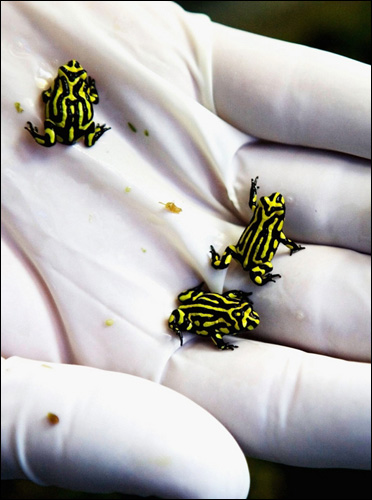Asher Kelman
OPF Owner/Editor-in-Chief
I'm impressed with the conservation work of the Australian Zoo near Sydney. A large number of species are threatened or severly endanged to survive in the next 10-50 years.
Some species are exinnct in their normal habitat. Others have little genetic diversity such that cooperating Zoos over the world swop animals to prevent such in breeding that the whole population is threatend by some new single environmental or infectious agent attack.
I was impressed by the wonderful pictures of Getty photographers reporting on the work in Australia in maintaining small communities of threatened frog species. Taronga Zoo is on Bradley's Head Road, Mosman, Sydney. This sounds pretty dry, however the pictures are amazing! Wow!

© 2007 Photo by Ian Waldie/Getty Images for editoral comment, no license is hereby given for any other use.
"Baby Corroboree Frogs walk across the gloved palm of reptile keeper Stuart Kozlowski at Taronga Zoo in Sydney, Australia. Around 130 of the endangered frogs are housed in a purpose built quarantine facility at the zoo to keep a safe population for genetic diversity." Source is the BBC News here
More information on conservation in this zoo here .
Conservation makes more sense when we see examples like this that are full of wonder. Nevertheless, we still need to face up to the fact that amphibians are globally threatened. They are literally dying out all over the world!
Originally, it was though to be just another consequence of global warming. Then it was found that a lot of amphibians are being devastated by a particular fungus.
Now, however, it appears that the amphibians are actually losing their habitat as the leaves that fall are now less or cleared and so they are squeezed out of existance.
Asher
Some species are exinnct in their normal habitat. Others have little genetic diversity such that cooperating Zoos over the world swop animals to prevent such in breeding that the whole population is threatend by some new single environmental or infectious agent attack.
I was impressed by the wonderful pictures of Getty photographers reporting on the work in Australia in maintaining small communities of threatened frog species. Taronga Zoo is on Bradley's Head Road, Mosman, Sydney. This sounds pretty dry, however the pictures are amazing! Wow!

© 2007 Photo by Ian Waldie/Getty Images for editoral comment, no license is hereby given for any other use.
"Baby Corroboree Frogs walk across the gloved palm of reptile keeper Stuart Kozlowski at Taronga Zoo in Sydney, Australia. Around 130 of the endangered frogs are housed in a purpose built quarantine facility at the zoo to keep a safe population for genetic diversity." Source is the BBC News here
More information on conservation in this zoo here .
Conservation makes more sense when we see examples like this that are full of wonder. Nevertheless, we still need to face up to the fact that amphibians are globally threatened. They are literally dying out all over the world!
Originally, it was though to be just another consequence of global warming. Then it was found that a lot of amphibians are being devastated by a particular fungus.
Now, however, it appears that the amphibians are actually losing their habitat as the leaves that fall are now less or cleared and so they are squeezed out of existance.
Asher





